The Free-Reed Journal
Articles and Essays Featuring Classical Free-Reed
Instruments and Performers
The Accordion and Fiddler on the Roof
by Henry Doktorski
copyright 2002
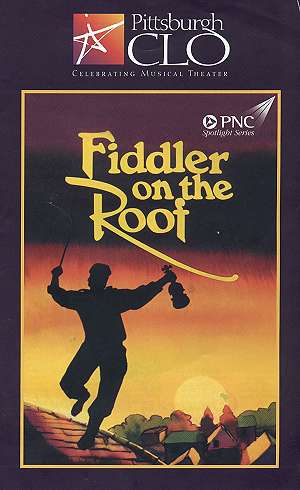 |
|
Civic Light Opera Program Cover
|
I had the pleasure of performing with the Civic Light Opera Orchestra of Pittsburgh, Pennsylvania, in 15 performances of Fiddler on the Roof from June 18 to 30, 2002 at the Benedum Center for the Performing Arts in Pittsburgh's downtown cultural district, which boasts of the third largest stage in the United States.
THE PLAY
The award-winning musical, based on the book by Joseph Stein with music by Jerry Bock and lyrics by Sheldon Harnick, captures the colorful story of one Jewish father's struggle to hold on to his family's traditions amidst the rebellious antics of his three independent daughters and the turmoil of an ever- changing world. The score includes such classics as: - If I Were a Rich Man
- Sunrise, Sunset
- Matchmaker, Matchmaker
- Tradition.
Fiddler on the Roof, originally based on the short story "Tevye and His Daughters" by Sholom Aleichem, was one of the first musicals to defy Broadway's established rules of commercial success. It dealt with serious issues such as persecution, poverty, and the struggle to hold on to one's beliefs in the midst of a hostile and chaotic environment. Criticized at first for its "limited appeal," Fiddler on the Roof struck such a universal chord in audiences that it became, for a time, the longest running production in the history of Broadway.
Set in 1905, Fiddler on the Roof takes place in Anatevka, a small Jewish village in Russia. The story revolves around the dairyman Tevye and his attempts to preserve his family's traditions in the face of a changing world. When his eldest daughter, Tzeitel, begs him to let her marry a poor tailor rather than the middle-aged butcher that he has already chosen for her, Tevye must choose between his own daughter's happiness and those beloved traditions that keep the outside world at bay. Meanwhile, there are other forces at work in Anatevka, dangerous forces which threaten to destroy the very life he is trying to preserve.
Fiddler on the Roof opened on September 22, 1964 with Zero Mostel in the leading role. It ran for 3,242 performances at the Imperial Theatre and opened the door for other musicals to deal with more serious issues. The 1971 screen version featured Norma Crane, Molly Picon, and Topol.
2. THE MUSIC
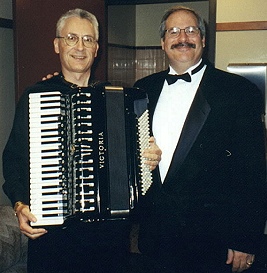 |
|
Doktorski and Maestro Barna.
|
Maestro Craig Barna, the Civic Light Opera Orchestra guest music director and conductor, said, "Fiddler is a great musical. It has a poignant story which touches our hearts and a wonderful score which includes an important accordion part. The accordion is important because it provides the flavor for the folk setting; it takes us back in time to a small Jewish village in Czarist Russia. The accordion helps define the location and time period for the play and it also sets the tone for the story."
Barna continued, "During the dress rehearsal, the directors kept asking the sound people to provide more and more accordion in the mix. The accordion has such an unusual and distinctive timbre, and it is rarely heard in musical theater or opera. We didn't want it to 'blend in' and disappear into the orchestra."
My wife, Mary Kay, attended one performance, sitting on a stool in the orchestra pit next to the conductor. She said, "It was a powerful experience watching the show up close. The music was powerful and the presence of the actors and actresses was powerful. It was just like sitting in the cockpit of a 747 jumbo jet!"
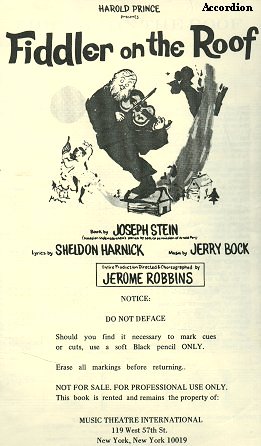 |
|
Cover page of accordion part
|
The orchestration for Fiddler was written by Don Waller and was scored for:
- a string orchestra consisting of violins, viola, cello and double bass
- a brass section consisting of trumpets, trombone and French horn
- a woodwind section consisting of flute, alto flute, clarinets, bass clarinet, oboe, English horn and bassoon
- a percussion/rhythm section consisting of drums, timpani, xylophone, piano, celeste, guitar, mandolin and accordion.
As an accordionist, I found Fiddler to be a pleasure to play. The accordion part is substantial: it is heard during each and every piece; all 35 of them, including scene change music.
From the opening Prologue to the concluding Exit music, the accordion contributes important musical substance, including many solos, to the orchestration. Sometimes the accordion is featured along with the strings or woodwinds, and sometimes it is featured alone without any accompaniment, such as in
- No. 7 Street Scene (If I Were a Rich Man)
- No. 19, the plaintive Finale to Act One
- No. 28 Incidental Music (Miracle of Miracles) in Act Two.
There are many register changes in the accordion part which featured all the eleven varieties of timbres the instrument can produce, from the 16-foot "bassoon" stop to the 4-foot "piccolo" stop, and all the combinations between. In addition, the left-hand manual's ponderous bass is featured in many songs. The accordion is used in three ways during the musical: 1. as a rhythm/accompaniment instrument, 2. as a melodic instrument and 3. as a harmonic instrument.
3. IF I WERE A RICH MAN
The song If I Were A Rich Man (No. 4) features an especially prominent accordion part. The main character, Tevye, laments:
Dear God, you made many, many poor people.
I realize, of course, that it's no shame to be poor.
But it's no great honor either!
So, what would have been so terrible if I had a small fortune?
Page 1
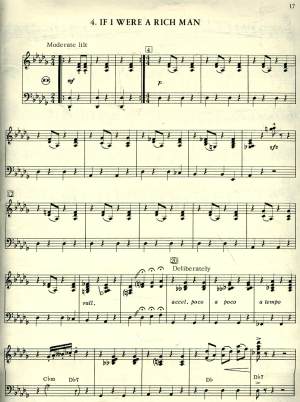 Click on image to enlarge.
Click on image to enlarge.
Copyright 1964 by Sunbeam Music Corp.
|
While Tevye recites his narrative, the music introduction begins: a vamp played by accordion, mandolin and double bass. At first the accordion is used in If I Were A Rich Man as a rhythm instrument, as an accompaniment to Tevye's singing.
If I were a rich man,
Daidle deedle daidle deedle daidle dum.
All day long I'd biddy biddy bum,
If I were a wealthy man.
I wouldn't have to work hard,
Daidle deedle daidle deedle daidle dum.
If I were a biddy biddy rich,
Deedle daidle deedle daidle man.
I'd build a big tall house with rooms by the dozen
Right in the middle of town.
A fine tin roof with real wooden floors below.
Page 2
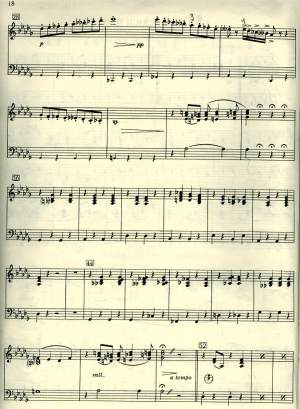 Click on image to enlarge.
Click on image to enlarge.
Copyright 1964 by Sunbeam Music Corp.
|
On page two, from measure 28 to 35, the accordion is used as a melodic instrument to illustrate the text: the instrument paints a tone poem of three staircases as Tevye sings,
There would be one long staircase just going up,
And one even longer coming down,
And one more leading nowhere just for show.
1. The ascending scale depicting the ascending staircase is a Db melodic minor scale (descending version). 2. The descending scale depicting the descending staircase is the same scale [Db melodic minor scale (descending version)] with an unexpected flattened second (Ebb).
3. The scale depicting the staircase going nowhere is a descending chromatic scale.
As the song continues, the accordion reverts back into its accompaniment mode.
I'd fill my yard with chicks
And turkeys and geese and ducks,
For the town to see and hear,
Squawking just as noisily as they can.
And each loud "quack" and "cluck"
And "gobble" and "honk"
Will land like a trumpet on the ear,
As if to say here lives a wealthy man.
During this verse (measure 36 to 51), the woodwind instruments (flute, clarinets and oboe) imitate the various clucking and quacking sounds of domesticated fowl.
Page 3
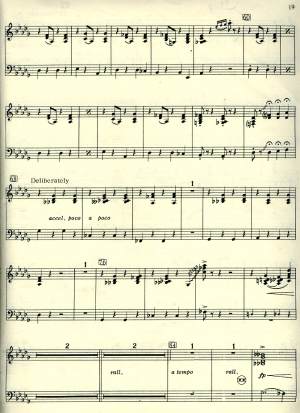 Click on image to enlarge.
Click on image to enlarge.
Copyright 1964 by Sunbeam Music Corp.
|
At the end of page two (measure 52) through page three (measure 67), Tevye sings,
If I were a rich man,
Daidle deedle daidle deedle daidle dum.
All day long I'd biddy biddy bum,
If I were a wealthy man.
I wouldn't have to work hard,
Daidle deedel daidle deedle daidle dum.
If I were a biddy biddy rich,
Daidle deedle daidle deedle daidle dum.
The accordion emphasizes a particular point in the following verse, (measures 68 through 83), as Tevye sings,
I see my wife, my Golde,
Looking like a rich man's wife
With a proper double chin;
Supervising meals to her heart's delight.
I see her putting on airs
And strutting like a peacock.
Oy! What a happy mood she's in;
Screaming at the servants day and night.
At measures 77 to 78, the accordion depicts the fan-shaped feathers of a peacock with an ascending glissando.
Page 4
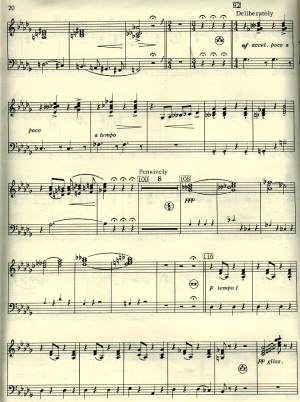 Click on image to enlarge.
Click on image to enlarge.
Copyright 1964 by Sunbeam Music Corp.
|
The mood changes abruptly in the next verse (measures 86 through 90) though as Tevye sings,
The most important men in town will come to fawn on me.
They will ask me to advise them like Solomon the wise:
"If you please, Reb Tevye, pardon me, Reb Tevye."
Posing problems what would cross a rabbi's eyes.
Boi, boi, boi, boi, boi, boi, boi, boi.
Here, the accordion is used as a harmonic instrument to imitate a synagogue organ or harmonium to underscore the importance a wealthy man commands.
The accordion again reverts to its accompaniment verse as Tevye sings measures 92 through 99,
And it won't make one bit of difference
If I answer right or wrong.
When you're rich, they think you really know.
The accordion once again imitates an organ during the following verse (measures 100 through 115)
If I were rich, I'd have the time that I lack
To sit in the synagogue and pray,
And maybe have a seat by the eastern wall.
And I'd discuss the holy books with the learned men
Seven hours ev'ry day.
This would be the sweetest thing of all.
Page 5
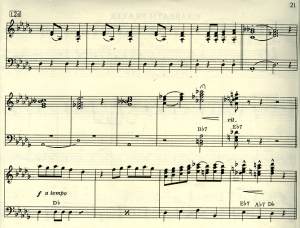 Click on image to enlarge.
Click on image to enlarge.
Copyright 1964 by Sunbeam Music Corp.
|
Tevye continues as the accordion reverts to its accompaniment mode,
If I were a rich man,
Daidle deedle daidle deedle daidle dum.
All day long I'd biddy biddy bum,
If I were a wealthy man
I wouldn't have to work hard
Daidle deedle daidle deedle daidle dum
From measure 128 to the end, the accordion again depicts an organ as Tevye sings:
Lord, who made the lion and the lamb,
You decreed I should be what I am.
Would it spoil some vast eternal plan
If I were a wealthy man?
4. BENEDUM CENTER FACTS
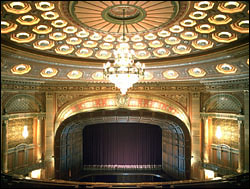 |
|
Benedum Center stage
|
- Seating capacity 2885
- Benedum Center is a $42 million restoration and expansion of the Stanley Theatre, built in 1928 as "a movie palace version of Versailles."
- Registered with the National Trust for Historic Places, every detail--from the 500,000 piece crystal chandelier to the gilded plasterwork--has been restored or replicated.
- Always noted for its intimacy and warmth and named "Number One Auditorium in the U.S." by Billboard even before restoration, Benedum Center today offers theatre-goers clear sight lines from all seat locations, wide, roomy seats relatively close to the stage, and exceptional acoustics.
- The Benedum Center is one of the Pittsburgh Cultural District's centerpieces. This one-time vaudeville hall has been renovated with grand style. Its stage is one of the largest in the country and dance "greats" such as the Merce Cunningham Dance Company, Dance Theatre of Harlem, Frankfurt Ballet, and Alvin Ailey American Dance Theater fill the stage with glorious movement and fabulous visuals.
- There are over 90 crystal chandeliers, torchieres and sconces in the theater, all but one are original. The Central Brass Company located in Reading, Pennsylvania, refurbished them.
- The Grand Lobby mirrors, marble and woodwork are all original.
- At the landing on each staircase in the Grand Lobby are 18-foot high original mirrors meant to be reminiscent of the Hall of Mirrors at the Palace of Versailles.
- The signature piece of the Benedum Center is the original main chandelier which weighs 4,700 pounds, is 20 feet high and 12 feet wide. It was restored in honor of the late H.J. Heinz II.
- Approximately 95% of the interior of the building is plaster. It took a fifteen person crew almost a full year to complete the plaster renovations.
- There are 1,500 feet of brass rail in the theater, most of which is original.
- On St. Patrick's Day in 1936, the theater flooded within two feet of the balcony. Several men were trapped for three days until police arrived in a motorboat and rescued them.
-
The Benedum Center for the Performing Arts was named in honor of the Claude Worthington Benedum Foundation, which made the largest contribution toward the restoration of the theater.
- The Benedum Center opened on Friday, September 25, 1987, with a show called Purely Pittsburgh. It was written by Dan Langen and produced by Mandy Levine. The show featured composers from Pittsburgh and performers with a Pittsburgh connection.
- In 1928, the Stanley cost $3 million to build. In 1987, the Benedum Center cost $43 million to restore.




 Click on image to enlarge.
Click on image to enlarge.  Click on image to enlarge.
Click on image to enlarge.  Click on image to enlarge.
Click on image to enlarge.  Click on image to enlarge.
Click on image to enlarge.  Click on image to enlarge.
Click on image to enlarge. 